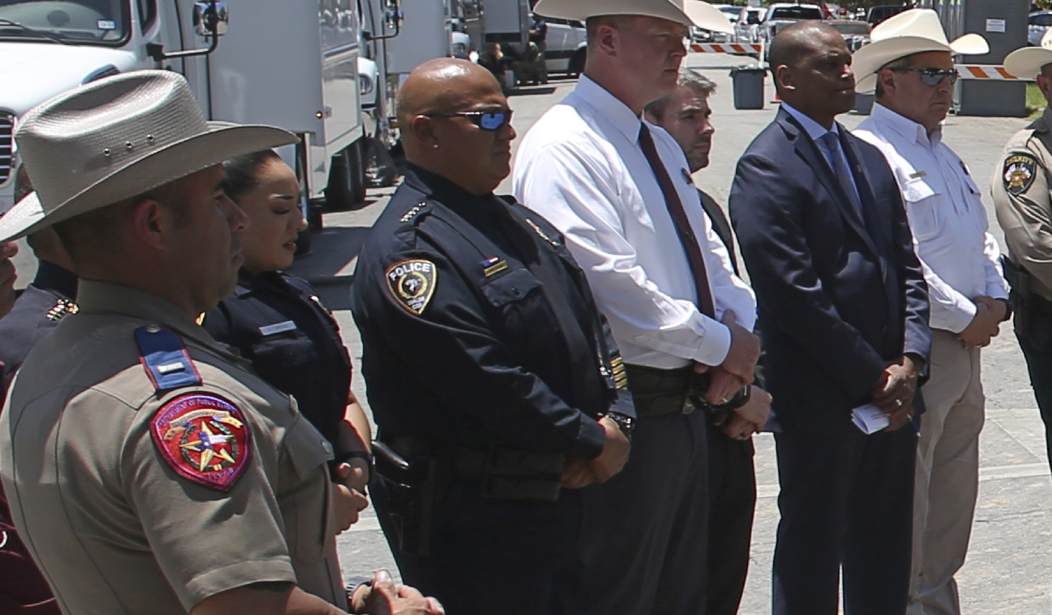The new report was issued by the ALERRT Center at Texas State University. ALERRT was set up in 2002 to provide law enforcement with training on how to deal with active shooters. Since then it has trained more than 130,000 law enforcement and fire officials nationwide based on social science research into past shootings. [link to site where you can download the report]
ALERRT training is research based. The ALERRT research team not only evaluates the efficacy of specific response tactics (Blair & Martaindale, 2014; Blair & Martaindale, 2017; Blair,
Martaindale, & Nichols, 2014; Blair, Martaindale, & Sandel, 2019; Blair, Nichols, Burns, & Curnutt, 2013;) but also has a long, established history of evaluating the outcomes of active shooter
events to inform training (Martaindale, 2015; Martaindale & Blair, 2017; Martaindale, Sandel, & Blair, 2017). Specifically, ALERRT has utilized case studies of active shooter events to develop
improved curriculum to better prepare first responders to respond to similar situations (Martaindale & Blair, 2019).
All that to say, this is the group’s area of expertise and they are definitely in a position to make judgments about the response to the shooting in Uvalde. There’s a detailed timeline of events in the report followed by an assessment of the tactical response. It reads like one failure after another. First there was the exterior door which, for some reason, wasn’t locked.
After the teacher closed the door, she did not check to see if the door was locked. Perhaps this was because the door is usually locked. However, on this day the door was not locked, and because it was not locked, the attacker was able to immediately access the building. This again highlights the importance of not circumventing access control procedures. Even if the teacher had checked to see if the door was locked, it appears that she did not have the proper key or tool to engage the locking mechanism on the door.
The report says there were painted rocks by several doors suggesting they were often propped open. I wonder if that was because of the need for extra ventilation in the summer. The report doesn’t speculate but I wonder if some of the money Uvalde spent on additional police might have been better spent on air conditioning so they could keep the exterior doors closed and locked in the summer.
Next, the report notes that one of the first officers responding drove up so fast that he drove right past the suspect who was still walking through the parking lot with a rifle. Finally, there was another officer who had a rifle and could have shot the suspect but didn’t.
…a Uvalde PD officer reported that he was at the crash site and observed the suspect carrying a rifle prior to the suspect entering the west hall exterior door. The UPD officer was armed with a rifle and sighted in to shoot the attacker; however, he asked his supervisor for permission to shoot. The UPD officer did not hear a response and turned to get confirmation from his supervisor. When he turned back to address the suspect, the suspect had already entered the west hall exterior door at 11:33:00. The officer was justified in using deadly force to stop the attacker. Texas Penal Code § 9.32, DEADLY FORCE IN DEFENSE OF PERSON states, an individual is justified in using deadly force when the individual reasonably believes the deadly force is immediately necessary to prevent the commission of murder (amongst other crimes). In this instance, the UPD officer would have heard gunshots and/or reports of gunshots and observed an individual approaching the school building armed with a rifle. A reasonable officer would conclude in this case, based upon the totality of the circumstances, that use of deadly force was warranted. Furthermore, the UPD officer was approximately 148 yards from the west hall exterior door. One-hundred and forty-eight yards is well within the effective range of an AR-15 platform. The officer did comment that he was concerned that if he missed his shot, the rounds could have penetrated the school and injured students. We also note that current State of Texas standards for patrol rifle qualifications do not require officers to fire their rifles from more than 100 yards away from the target. It is, therefore, possible that the officer had never fired his rifle at a target that was that far away. Ultimately, the decision to use deadly force always lies with the officer who will use the force. If the officer was not confident that he could both hit his target and of his backdrop if he missed, he should not have fired.
If any of these three things had been different (the unlocked door, the officer who drove past the suspect, the officer who hesitated to shoot) this might have been over before it really started. But once the suspect got inside the school there were more problems. The report says there are unverified claims that the lock on the door to room 111 was broken.
We received information from the investigating officer that the lock on room 111 had been reported as damaged multiple times; however, this has not been confirmed through work orders at this time. Regardless, the suspect is seen entering the room, exiting the room, and then reentering the room again prior to officers entering the building at 11:35:55. The only way to engage the lock is to insert a key from the hallway side of the door. At no point is the suspect observed entering the hallway and engaging the locking mechanism. Based upon this, we believe that the lock to room 111 was never engaged.
That’s significant not only because it allowed the suspect to go in and out of the room at will but also because it means the door was probably never locked. And that contradicts what Chief Pete Arredondo claimed in a previous interview with the Texas Tribune. Here’s how that previous story opened:
Only a locked classroom door stood between Pete Arredondo and a chance to bring down the gunman. It was sturdily built with a steel jamb, impossible to kick in.
He wanted a key. One goddamn key and he could get through that door to the kids and the teachers…
Arredondo checked to see if the door on the right, room 111, would open. Another officer tried room 112. Both doors were locked.
Arredondo remembers the gunman fired a burst of shots from inside the classroom, grazing the police officers approaching from the north. Some of the bullets pierced the classroom door, and others went through the classroom wall and lodged in the wall adjacent to the hallway, where there were other classrooms. The officers on the north end of the hallway retreated after being shot, but they weren’t seriously injured and returned shortly after to try to contain the gunman.
Because the gunman was already inside the locked classroom, some of the measures meant to protect teachers and students in mass shooting situations worked against police trying to gain entry.
Obviously the gunman’s ability to enter the room twice and the fact that the door couldn’t be locked without a key he didn’t have suggests the door wasn’t locked. That’s very much at odds with the story that the locked door is what kept police from entering sooner. Something doesn’t add up here. And the report also notes that the officers who first entered the hallways to engage the shooter never got to the door. [emphasis in original]
As the officers approached the doors, the suspect began firing. This gunfire caused both teams of officers to retreat from the doors. We note that the officers did not make contact with the doors (i.e., they never touched any part of the doors). The team approaching from the north fell back to the T-intersection of the west and south hallways. This position is approximately 67 feet from the doors of rooms 111 and 112. The team approaching from the south fell back to the south end of the south hallway. The team in the south hallway were not visible on camera, so their distance from the affected classrooms is unknown.
Whether the door was locked or not, the report ultimately faults the officers for not following their training to engage the shooter at this point.
ALERRT trains the widely-used ABCs of cover – Accurate return fire, Body armor, and Cover (ALERRT & FBI, 2020. p. 2-21; Blair et al., 2013). The ABCs give the first responder a tiered approach to achieving cover while maintaining control of the situation. Further, the ABCs are presented in order of preference (A first, B second, C third). As noted in Figure 6, there was a window in the center of each classroom door. Officers could have utilized the window to send accurate return fire back at the suspect. Even though the room was darker than the hallway, the suspect would have been backlit by the exterior windows and muzzle flashes would have been present. Obviously, this return fire must be consistent with the fundamental firearms safety rules (e.g., the officers must ensure that students will not be hit by the officers’ return fire). Any officer with body armor should have squared their body armor to the threat to improve protection. In this situation, we don’t believe the last course of action (moving to cover) was a viable option because the interior construction of the school would not stop bullets, and therefore, was not cover. Maintaining position or even pushing forward to a better spot to deliver accurate return fire would have undoubtedly been dangerous, and there would have been a high probability that some of the officers would have been shot or even killed. However, the officers also would likely have been able to stop the attacker and then focus on getting immediate medical care to the wounded.
This report probably won’t be the last word on this shooting. Maybe some of the details are wrong. But based on what we know now, it looks as if officers ignored their training and never even got very close to an unlocked door because they wanted to avoid getting shot themselves. That’s understandable on a human level but in this instance where children were already shot and dying, it’s not good enough.








Join the conversation as a VIP Member